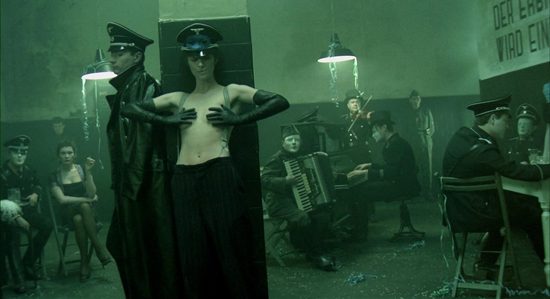From Monthly Film Bulletin, November 1974, Vol. 41, No. 490. — J.R.
Portiere di Notte, Il (The Night Porter)
Italy, 1973
Director: Liliana Cavani
Cert—X. dist—Avco-Embassy. p.c—Lotar Film. A Robert Gordon
Edwards/Esa De Dimone production. A Joseph E. Levine presentation
for Ital Noleggio Cinematografico. p—Robert Gordon Edwards. p. staff—
Umberto Sambuco, Dino di Dionisio, Roberto Edwards, (Vienna) Otto
Dworak. asst. d–Franco Cirino, Paola Tallarigo, (Vienna) Johann
Freisinger. sc–Liliana Cavani, Italo Moscati. story–Liliana Cavani,
Barbara Alberti, Amedeo Pagani. ph–Alfio Contini. co1–Technicolor;
prints by Eastman Colour. col. sup–Ernesto Novelli. ed–Franco Arcalli.
a.d–Nedo Azzini, Jean-Marie Simon. set dec–Osvaldo Desideri. m/m.d—
Daniele Paris. cost–Piero Tosi. sd. ed–Michael Billingsley. sd. rec—
Fausto Ancillai. sd. re-rec–Decio Trani. post-synchronisation d–Robert
Rietty. sd. effects–Roberto Arcangeli. l.p–Dirk Bogarde (Max),
Charlotte Rampling (Lucia), Philippe Leroy (Klaus), Gabriele Ferzetti (Hans),
Giuseppe Addobbati (Stumm), Isa Miranda (Countess Stein), Nino
Bignamini (Adolph), Marino Mase’ (Atherton), Amedeo Amodia (Bert),
Piero Vida (Day Porter), Geoffrey Copleston (Kurt), Manfred Freiberger
(Dobson), Ugo Cardea (Mario), Hilda Gunther (Greta), Nora Ricci
(Neighbour), Piero Mazzinghi (Concierge), Kai S. Seefield (Jacob).
10,603 ft. 118 mins. English version.
Vienna, 1957. Max, a sadistic SS officer during the war, conceals
his former identity in a job as night porter in a luxury hotel, where
he caters to the jaded tastes of some of his former colleagues, also
in hiding at the hotel. Together they have formed a self-styled
‘therapy’ group, accumulating evidence of their former atrocities
so that it can be destroyed while they exorcise their feelings of guilt.
Shortly before Max’s past is due to be reviewed by the group, the
unexpected arriyal at the hotel of Lucia Atherton — a concentration
camp victim of Max’s sadism who became his lover, and is presently
married to an opera conductor — stirs up Max’s memories as well
as her own. Lucia fails to reveal Max’s identity to her husband, and
when the latter leaves for Frankfurt she chooses to stay behind,
promising to join him later in his concert tour. Before long, she and
Max have resumed their sado-masochistic affair. Max refuses to
acknowledge Lucia to his former colleagues, and after she moves in
with him and ignores the efforts of the police to locate her, Max’s
fellow Nazis lay siege to the flat, fearful that the couple’s behaviour
will lead to their own exposure. After access to food, electricity and
water has been cut off for an extended period, Max and Lucia
emerge from the flat in their former outfits — his SS uniform and
her party dress — and are shot down on a bridge.
A plot composed almost exclusively of implausible characters
and improbable events; sound recording and post-synchronisation
atrocious even by Italian potboiler standards; shots, dramatic
situations and gimmicks seemingly imitated or approximated from
Last Tango in Paris; sluggish pacing and laborious exposition . . .
Theoretically, one could be describing the latest anonymous
exploitation film. What chiefly distinguishes The Night Porter from
this familiar category are two significant factors, possibly related:
(1) the film has a Nazi-related theme which it pursues with
ponderous intransigence, and (2) it has been widely acclaimed for
its seriousness, audacity and overall achievement by critics on both
sides of the Atlantic. Perhaps the only credible explanation of this
second factor is a simple confusion of thought with deed, or subject
with treatment. There might, conceivably, be something to be said
for the film’s potential thematic interest apart from the sure-fire
formula of combining sex and Nazis — namely, the sexual impulses
that are suggested or touched upon by the Nazi horrors, and the
related ambiguities reflected in Max’s shift of role from persecutor
to victim. If Cavani had established her intrigue in either a believable
setting (e.g., a Grand Hotel containing more guests than her central
characters) or a stylistically coherent non-realistic one, and delineated
it with even a modicum of visible intelligence, originality,
consistency or taste, the strength of her theme alone might have
sustained the film. But quite apart from the numerous Last Tango
replays (which extend from a virtual substitution of jam for butter
in a ridiculously over-acted sexual interlude to a fancy pan across
a bridge in nothing less than the final shot), the performances are
sufficient to place the film in the realm of the grimly risible: Charlotte
Rampling, looking rather embalmed throughout, alternating
between two or three cliché poses (usually Caged Animal or
Martyred Jeanne d’Arc), and Dirk Bogarde’s understandably
uncomfortable efforts to link together all the stray notions of his
character dictated by the script into some recognisable form of
behaviour, which results in the spectacle of a talented actor skating
in grease — and a parody of the various tics he has used to better
effect in previous sadist or masochist roles. As if this weren’t
enough, the concentration camp flashbacks are delivered with all
the trappings of the worst salon art: trite arrangements of bed-
frames to suggest prison bars bathed in kitschy hues of copper or
smoky blue, decked out with arty camp-victim poses, and
accompanied at one point by passages from The Magic Flute –
as if to guarantee the project’s cultural credentials, and at the same time
certify the universal significance of a subject that the director
apparently felt needed some tarting up. Beside such a sensibility,
the visual rhetoric of a film like The Pawnbroker (with its otherwise
comparable flashbacks) seems in comparison a model of integrity,
formal daring, ethical courage and restraint.
JONATHAN ROSENBAUM



